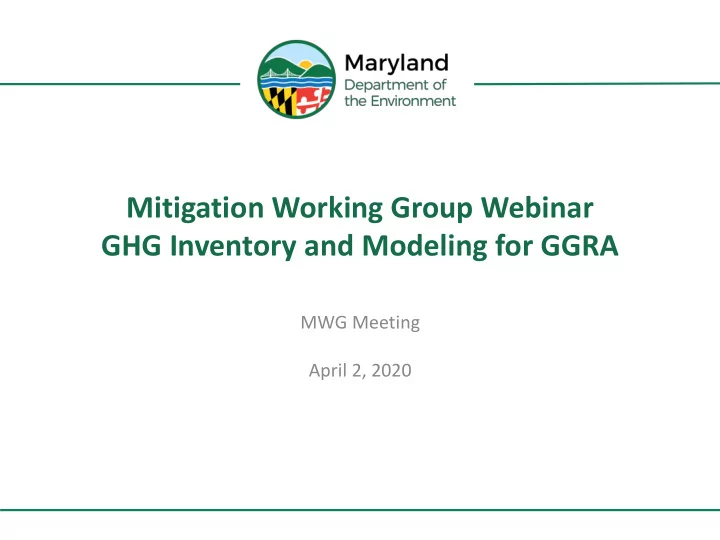

Mitigation Working Group Webinar GHG Inventory and Modeling for GGRA MWG Meeting April 2, 2020
Agenda Today 1. Updating GHG Inventory Methodology 2. Updating GGRA Modeling: New Reference Case Results 3. Updating GGRA Modeling: Policy Scenario Discussion
Reminder: Inventory and Modeling MDE’s Inventory estimates emissions that have occurred. 120 Historic Goals MD GHG Emissions Accounting for Sequestration 2006 Baseline 100 2011 2014 80 25 by 20 (MMTCO2e) Final 2017 Emissions 60 40 by 30 40 20 0 2005 2010 2015 2020 2025 2030 Maryland greenhouse gas emissions, accounting for sequestration. Note favorable weather drove additional reductions in 2017.
Reminder: Inventory and Modeling MDE’s Inventory estimates E3’s PATHWAYS Model estimates emissions that have occurred. emissions that will occur in the future. Maryland greenhouse gas emissions, accounting for sequestration. The Reference Case estimates emissions under no new programs (not the plan).
Updating GHG Inventory Methods • MDE has been performing GHG inventories for a long time, so some parts of our methodology are old. • Updating methodology requires revising all prior inventories, including 2006. – Changing the 2006 baseline changes the required emission reductions under the GGRA (our goals!) – MDE has avoided changing the methodology for this reason. • 2020 is a goal year, so now is the time to update. • These changes must be transparent; MWG participation is essential.
Proposed Inventory Changes 1. Easy: newer global warming potentials (GWPs) – Latest are from IPCC Fifth Assessment Report (AR5). 2. Difficult: Better forest data (LIDAR, satellites, etc) – Current inventory relies on EPA tool and suspended data. – DNR (Elliott Campbell) to coordinate w/ state agencies, UMD, NASA. 3. Very Difficult: Fugitive methane emissions – Current inventory relies on landfill models and downscaled national averages from EPA tools. – MDE to coordinate w/ UMD (Dickerson et al ) on other measurements.
Updated Global Warming Potentials GWPs convert all GHGs to MDE Inventories: SAR vs AR5 CO2-equivalent (e.g. 110 MD GHG Emissions Accounting for Sequestration “Methane is 28 times more 100 potent than CO2”) 90 80 68.4 MDE uses GWPs from IPCC 70 (MMT CO2e) Second Assessment Report 53.0 60 (SAR) 67.4 50 52.5 40 Latest are IPCC Fifth 30 Assessment Report (AR5) 20 10 Updated values marginally 0 increase MD GHGs. 2005 2010 2015 2020 2025 2030 Old (SAR) New (AR5)
Call for Participation • MDE, DNR, etc will update MWG as inventory work continues this year. • MWG members are welcome to volunteer to join more detailed conversations on forests and methane. – Email Chris Hoagland: chris.hoagland@maryland.gov • Updated methodology will be applied when we perform 2020 inventory next year.
Updating GGRA Modeling: Ref Case • Reminder: we start policy impact analysis with a “Reference Case” – What happens under no new effort? • Impact estimates from new programs come from comparisons to the Reference Case • Updates discussed at February MWG meeting • E3 presenting updated results today.
Turn to E3 Presentation
Updating GGRA Modeling: Policy Scenarios • For the Draft Plan, we analyzed 4 policy scenarios: MD Historical Inventory 100 Greenhouse Gas Emissions (MMT CO2e) Reference 80 (no new effort) 25% below 2006 Policy Scenario 1 Emissions 60 (continue current effort) 40% below 2006 Policy Scenario 4 Emissions (GGRA Draft Plan) 40 Policy Scenario 3 (MCCC/Carbon Fee) 20 Policy Scenario 2 (80% by 2050) 80% below 2006 Emissions 0 2000 2010 2020 2030 2040 2050
Updating GGRA Policy Scenarios • What is best use of MDE resources to incorporate MWG & MCCC input? – MDE can do another “MWG Run” like last time, but it can’t be as complex as carbon fee. • What are most important assumptions to evaluate in sensitivity analysis? – Last time: CAFE rollback, Calvert Cliffs retirement, and consumer adoption of EVs and efficient appliances.
Additional Slides
100-year vs 20-year GWPs • GWPs evaluate impact relative to CO2 over both 20 years and 100 years. • MDE uses 100-year value in inventory and GGRA Plan, consistent with national and international standards – ie the Greenhouse Gas Protocol and UNFCCC rules for implementing the Paris Agreement • Good reason to use the 20-year value in other areas – eg MDE’s estimates in natural gas system rulemaking and fracking analysis
Addressing Uncertainty • What if: – The Federal government rolls back vehicle standards? – Consumer adoption of EVs is half of what we modeled? – Consumer adoption of efficient appliances is half of what we modeled? – All of those things happen at once? We still meet the 2030 goal, but without as much extra reduction.
Recommend
More recommend